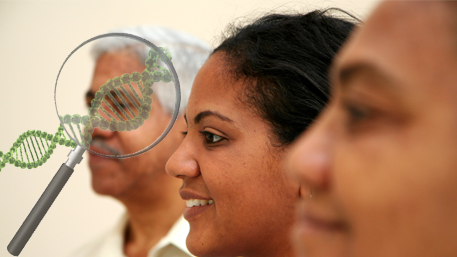Public Health Genomics Priorities Through a Health Equity Lens
Posted on by
Achieving Health Equity in Genomics and Precision Medicine is More Important than Ever
The CDC Office of Genomics and Precision Public Health is undergoing strategic planning to identify priorities and actions for genomics and precision medicine. As we embark on this work, we are focusing on health equity. The potential for genomics and precision medicine to improve population health comes with the real risk that benefits will not materialize for all people. Our goal is to develop a set of priorities and actions that can help ensure that everyone has the opportunity to reap the health benefits of advances in genomics and precision medicine.
Steady Progress in Genomic Medicine, but Disparities Remain in Implementation and Impact
Clinical applications of human genomics have accelerated in the past decade, and many have reached health practice across the lifespan. Genomic testing for screening, prevention, diagnosis, and treatment of human diseases encompasses newborn screening, childhood diseases, adult chronic disease such as cancer, heart disease and diabetes, mental health, as well drug safety and effectiveness.
CDC maintains an expanding list of genomic applications classified by levels of evidence, or “tiers.” Applications currently classified as having tier 1 guidelines based on systematic reviews and recommendations include genomic testing or family health history applications with sufficient scientific evidence for ability to prevent disease, in millions of people in the United States. Examples of tier 1 genomic applications include hereditary breast and ovarian cancer, Lynch syndrome, hereditary hemochromatosis, and hypertrophic cardiomyopathy. Other emerging areas include diagnosis of rare diseases, population screening, carrier testing, and precision oncology.
In the past decade, implementation of genomics in practice has been uneven at best, not reaching all segments of the population. There is evidence of access and uptake disparities by socioeconomic status, race or ethnicity, disabilities and rurality.
Here are a few example of such disparities:
- Inequities in multi-gene hereditary cancer testing: lower diagnostic yield and higher VUS rate in individuals who identify as Hispanic, African or Asian and Pacific Islander as compared to European
- BRCA Genetic Testing and Receipt of Preventive Interventions Among Women Aged 18-64 Years with Employer-Sponsored Health Insurance in Nonmetropolitan and Metropolitan Areas – United States, 2009-2014
- Prevalence and Predictors of Cholesterol Screening, Awareness, and Statin Treatment Among US Adults With Familial Hypercholesterolemia or Other Forms of Severe Dyslipidemia (1999-2014)
- Disparities in BRCA counseling across providers in a diverse population of young breast cancer survivors
More studies on health disparities in genomic medicine can be found by searching our Health Equity page in our Public Health Genomics and Precision Health Knowledge Base.
Ensuring that Everyone has an Opportunity to be as Healthy as Possible
We believe that public health strategies to improve health equity in genomics and precision medicine should go well beyond addressing underrepresentation in discovery research; we must assess how genomic testing and services can actually be implemented in diverse health care settings and communities. In addition, we also need to increase community awareness and engagement and to build provider competence in human genomics. At present, there is a dearth of workforce capacity for clinical and public health practice in human genomics, particularly in underserved populations. Applied public health genomics research is also needed in order to integrate findings into guidelines and programs that are designed to benefit all communities. Because tier 1 genomic applications are already available to save lives and promote health for all people, the time for action is now.
Partnerships are at the core of this planning effort. We are enhancing and leveraging collaborations with many groups including other federal agencies, state public health departments, health care organizations, academia, patient organizations, industry and communities. An important goal is to design, implement, and evaluate population-level and healthcare interventions that can reach all people, with a conscious focus on assessing gaps in access and communicating the benefits of policies that promote delivery of needed and effective genomic services to people who have historically been left out.
Genomics and Health Equity Matters
We are seeking input from a wide variety of experts and partners on immediate and near-term public health actions that can help ensure evidence-based genomic applications are made available to all. Our framework is to use the traditional essential public health services model viewed through a health equity lens: assessment; evidence synthesis, policy and guidelines; implementation, pilot community programs, tools and resources and workforce development.
We would like to hear from our readers about the most important actions that public health leadership and programs at the federal, state, Tribal and local levels, can take in the next decade to promote greater equity in genomic medicine. The bottom line is, how can we fulfill the promise of genomics and precision medicine for everyone? Please submit your comments below.